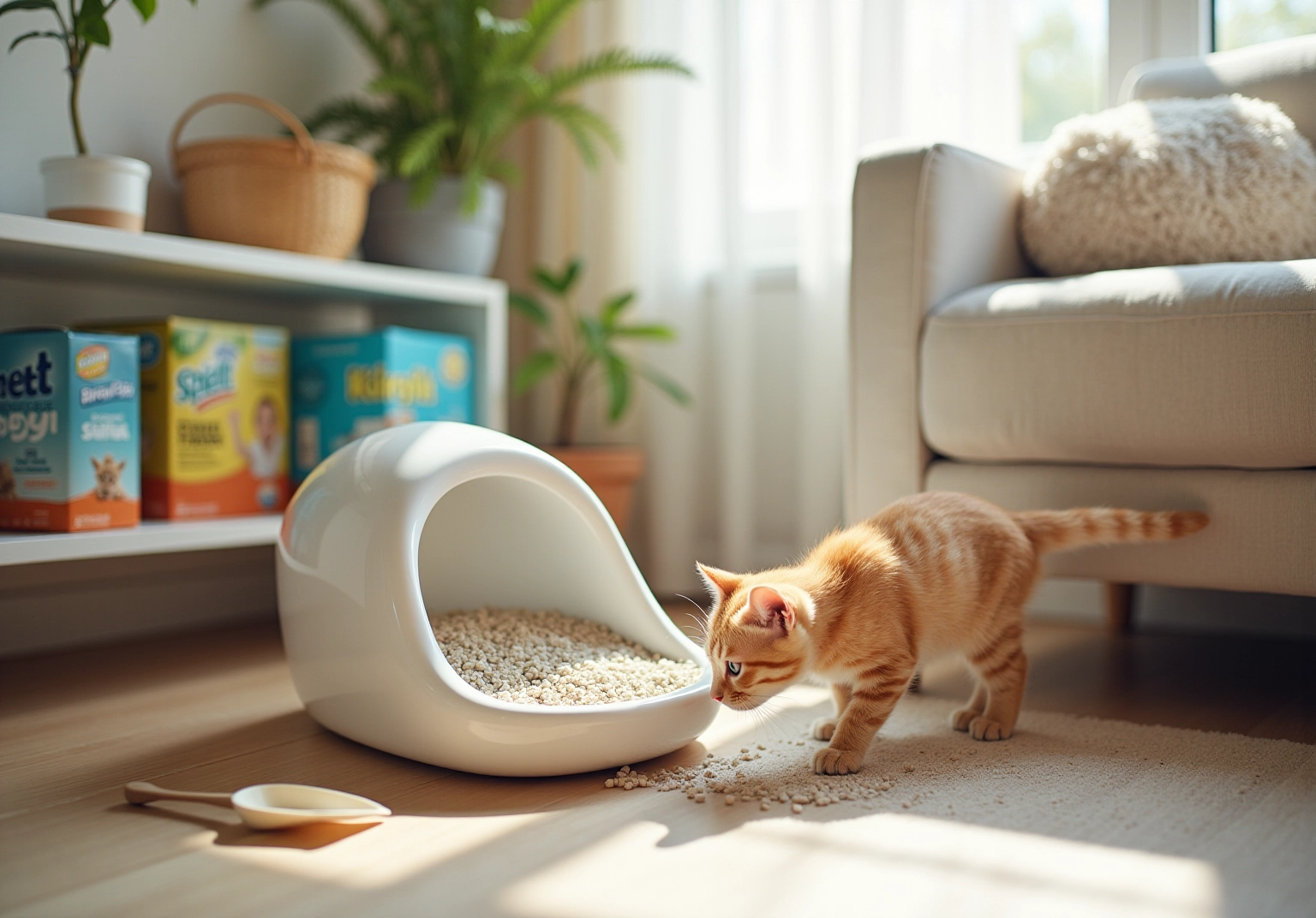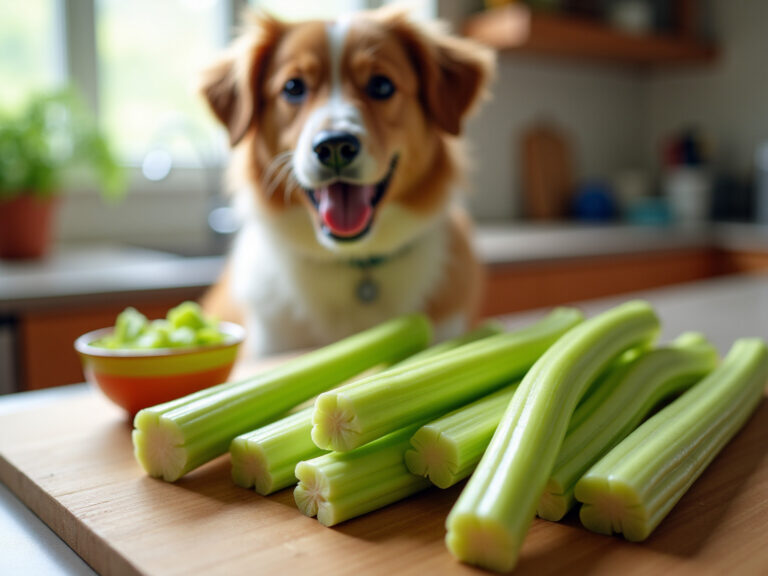Best Kitty Litter: Compare Features, Pros, and Suitability
Overview
In this article, we understand that choosing the right cat litter is an important decision for pet owners, especially when it comes to creating a nurturing environment for your furry family members. We explore various types of cat litter, highlighting their features, pros, and suitability for different cats, all aimed at helping you make informed choices that cater to your beloved pets’ needs.
Clumping clay litter stands out as the most popular option, celebrated for its practicality and effectiveness in odor control. However, we also delve into other wonderful choices, such as biodegradable and silica gel litters, ensuring that every pet owner can find something that aligns with their preferences and values.
As you navigate through these options, remember that each choice contributes to the comfort and happiness of your pets. We invite you to consider what will best suit your cat’s needs, fostering a caring and supportive atmosphere at home. Your journey to finding the perfect cat litter can be a rewarding one, filled with love and understanding for your furry companions.
Introduction
Navigating the vast array of cat litter options can feel daunting for pet owners. With choices that range from clumping clay to biodegradable materials, each type presents unique benefits designed to meet the diverse needs of your furry family members. The real challenge, however, lies in identifying which litter aligns best with your individual preferences and your cat’s specific requirements.
What factors should you consider to ensure a clean, comfortable, and nurturing environment for your beloved pets?
Explore Different Types of Cat Litter
Cat litter comes in various types, each designed to meet the unique needs of your furry family members:
-
Clumping Clay Litter: This is the most beloved choice among cat caregivers, crafted from sodium bentonite clay. It forms solid clumps upon contact with moisture, making scooping and maintenance a breeze. An impressive 64% of cat caregivers prefer clumping material, recognized as the best kitty litter for its practicality and efficiency in managing odors. Notably, 73% of cat owners in the U.S. opt for scoopable clay products, which are regarded as the best kitty litter, highlighting its widespread appeal.
-
Non-Clumping Clay Litter: While generally more budget-friendly, this type absorbs moisture without forming clumps, requiring more frequent changes. Its lower cost may attract budget-conscious pet owners, but it often demands additional effort to maintain cleanliness.
-
Silica Gel Litter: Composed of silica crystals, this litter excels in moisture absorption and odor control. It typically lasts longer than clay options, making it a practical choice for busy households. However, some cats may not favor its texture.
-
Biodegradable Litter: Eco-friendly options made from materials like corn, wheat, pine, and recycled paper are becoming increasingly popular among environmentally conscious pet owners. These choices provide an eco-friendly selection while still delivering effective scent management. The trend towards biodegradable waste reflects a growing consumer preference for sustainable products.
-
Crystal Litter: This type consists of tiny crystals that effectively absorb moisture and control odors. It generates minimal dust and boasts a longer lifespan than conventional clay products, although some cats may find it less comfortable.
As the cat waste market evolves, trends indicate a growing preference for clumping products. The global cat waste products market is projected to reach USD 16.63 billion by 2030. Veterinarians often recommend the best kitty litter, particularly clumping material, for its convenience and ability to create a cleaner box environment, which is essential for your cat’s health and well-being. Additionally, 29% of consumers purchased extra-strength odor control products, underscoring the importance of odor management when choosing a substrate. By understanding these options, you can make informed decisions that align with your pets’ preferences and your own cleaning habits, ensuring a nurturing environment for your beloved companions.
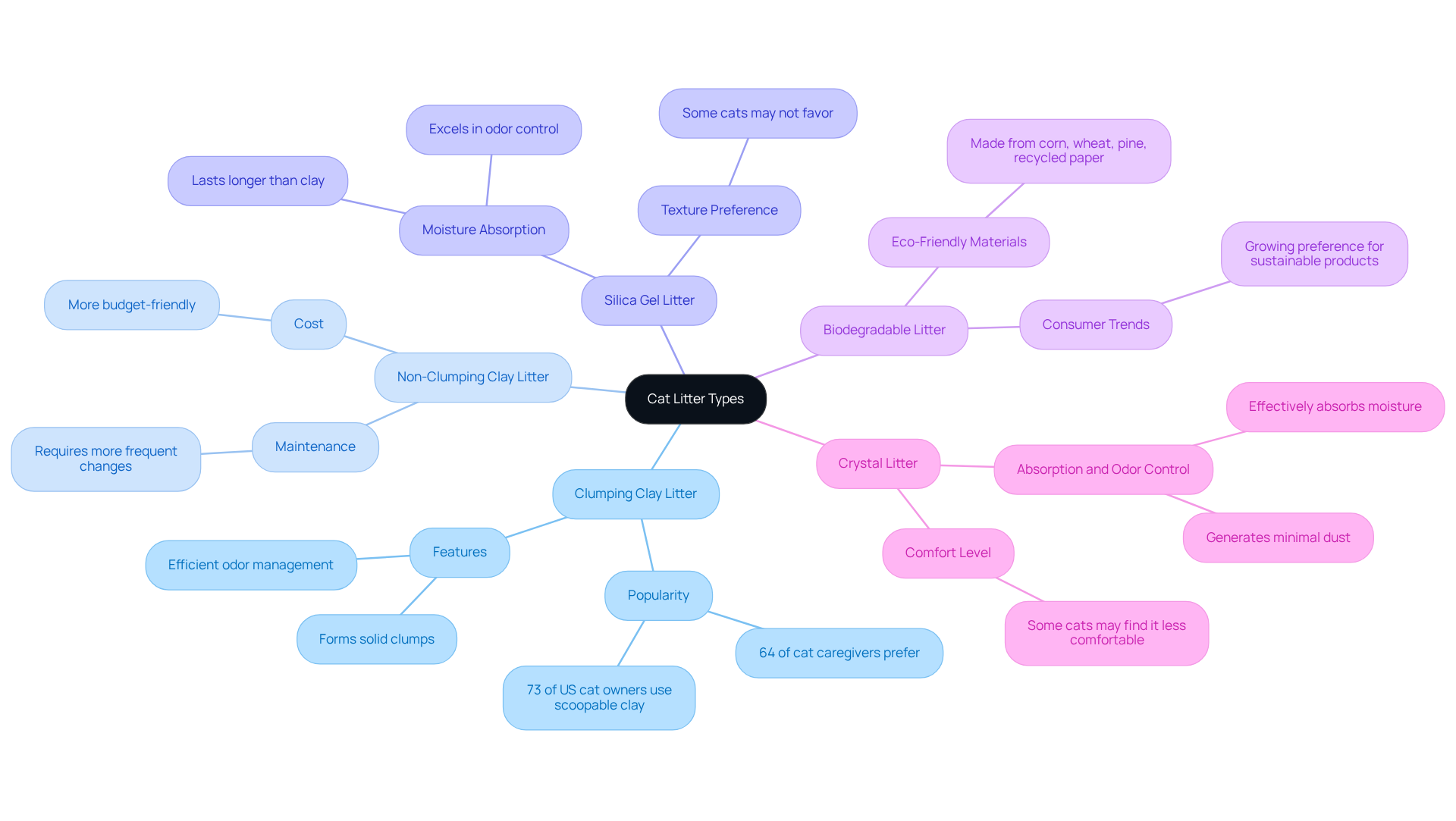
Analyze Unique Features of Leading Cat Litter Brands
The cat litter market showcases several prominent brands, each uniquely tailored to meet the diverse needs of pet owners, ensuring a nurturing environment for your furry family members:
- Dr. Elsey’s Ultra Cat Litter: Known for its exceptional clumping ability and low dust formula, this litter is especially beneficial for sensitive cats. It promotes a cleaner environment, helping to reduce respiratory issues. With a strong market presence, Dr. Elsey’s focuses on hypoallergenic properties, appealing to health-conscious pet caregivers who prioritize their pets’ well-being.
- Tidy Cats: Offering a variety of formulas, including options for multi-cat households, Tidy Cats excels in odor control and clumping. This reliability makes it a favorite among cat enthusiasts. Nestlé Purina’s Tidy Cats is also recognized for its innovative packaging and formulations, catering to the growing demand for convenience and effectiveness in pet care.
- World’s Best Cat Bedding: Crafted from whole-kernel corn, this product is both clumping and flushable, attracting eco-conscious consumers who value sustainability without compromising performance. The brand’s commitment to environmentally friendly practices resonates with a significant portion of the market, as reflected in its impressive sales growth.
- PrettyLitter: This unique crystal-based substrate changes color to indicate potential health concerns in cats, providing pet caretakers with an innovative way to monitor their pets’ health. The positive consumer feedback highlights its effectiveness in early health detection, an increasingly vital aspect for caring pet owners.
- Ökocat: Made from reclaimed wood, this biodegradable litter is highly absorbent and offers excellent odor control, aligning with the rising demand for eco-friendly pet care products. Ökocat’s dedication to sustainability positions it favorably in a market that increasingly favors green alternatives, as evidenced by recent trends.
These brands cater to a variety of needs, from effective clumping to health monitoring, highlighting the importance for cat owners to choose the best kitty litter that aligns with their specific preferences and the unique characteristics each brand offers. As the cat waste market is projected to grow significantly, with a CAGR of 7.03% from 2025 to 2035, understanding these distinctive attributes is essential for making informed choices that benefit both pets and their caregivers.
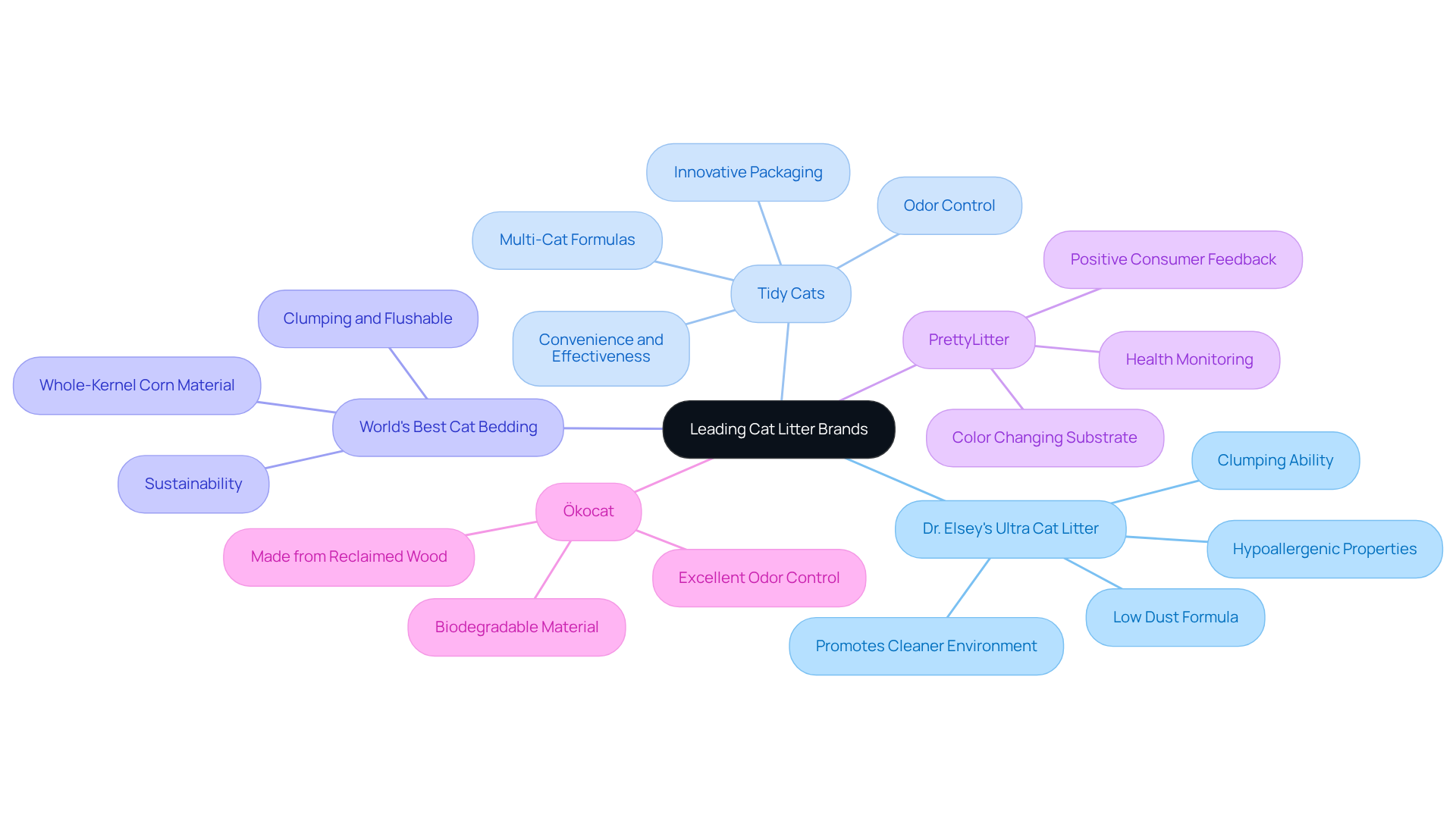
Evaluate Pros and Cons of Each Cat Litter Option
Choosing the best kitty litter is essential for creating a nurturing environment for your furry family members. Here’s a caring breakdown of the pros and cons of various cat litter types to help you make an informed decision:
-
Clumping Clay Litter:
- Pros: Easy to clean, good odor control, widely available.
- Cons: Dusty, can be heavy, not biodegradable.
-
Non-Clumping Clay Litter:
- Pros: Economical, absorbs moisture well.
- Cons: Requires more frequent changes, less effective at scent control.
-
Silica Gel Litter:
- Pros: Long-lasting, excellent odor control, low dust.
- Cons: Some felines may dislike the texture, can be more expensive.
-
Biodegradable Litter:
- Pros: Eco-friendly, often made from natural materials, safe for cats.
- Cons: May not clump as well, can be more expensive.
-
Crystal Litter:
- Pros: Low dust, absorbs moisture effectively, lasts longer.
- Cons: Can be uncomfortable for some cats, may not control odors as well as clay.
Understanding these advantages and disadvantages can empower you as a cat owner to select the best kitty litter for your beloved pets’ needs and preferences. Remember, your choice contributes to their comfort and happiness, so take your time in making the best decision for your nurturing home.
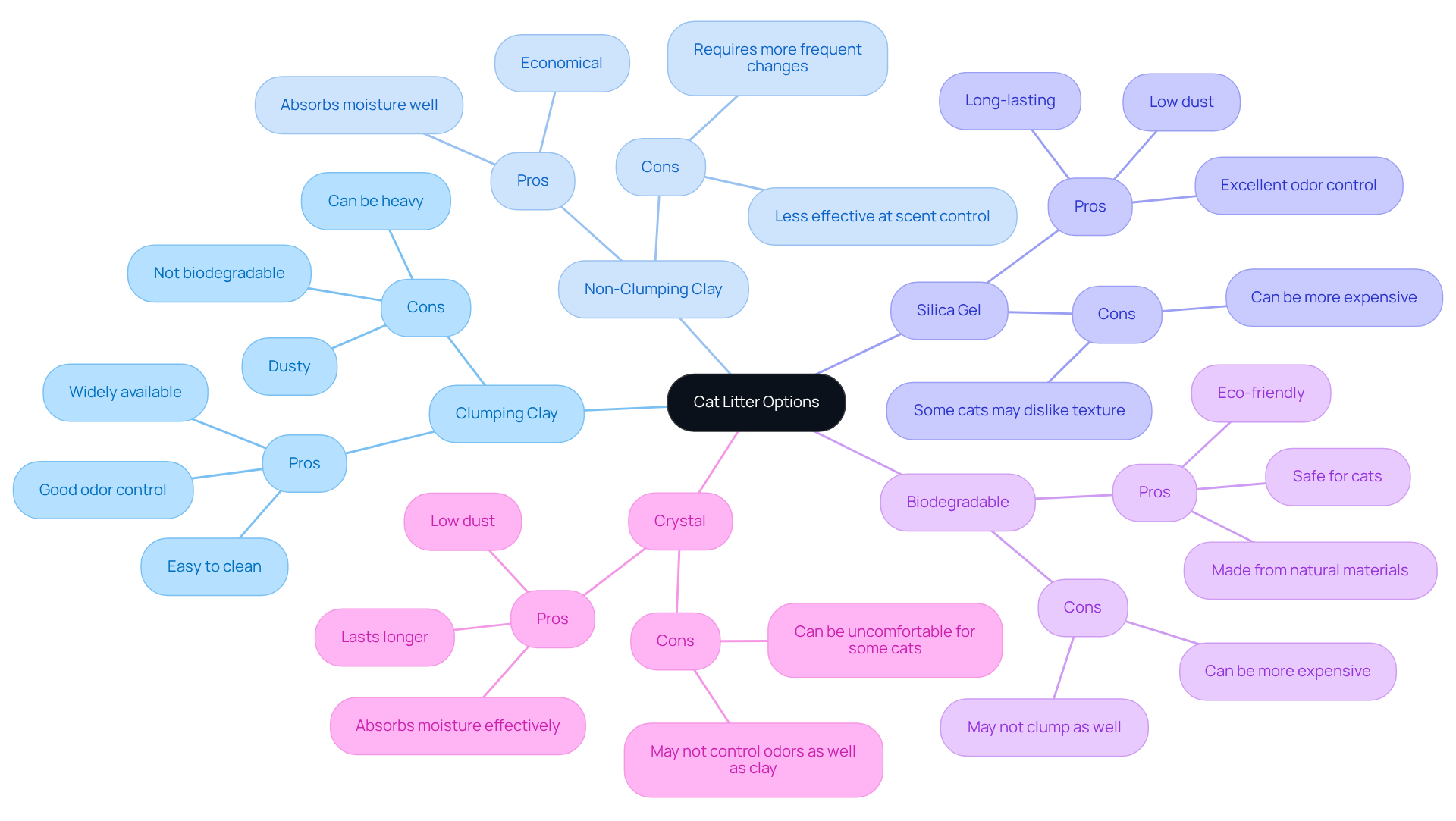
Determine Suitability for Different Cat Needs
Choosing the best kitty litter is essential for ensuring the comfort and well-being of your furry family members. Let’s explore some important considerations tailored to different needs:
-
Kittens: For your playful little ones, lightweight, low-dust clumping material is the best choice. This type of substrate makes their learning process smoother and less overwhelming. It helps them adjust to using the litter box effectively while minimizing respiratory irritants, creating a nurturing environment.
-
Senior Felines: Our older companions often thrive with softer, biodegradable materials that are gentle on their delicate paws. These substrates offer both comfort and ease of scooping, which is essential for maintaining cleanliness. Research indicates that fine grain textures enhance comfort, making it easier for senior cats to dig and use the litter box. Notably, the Friedman test revealed significant results at p = 0.0007, underscoring the preference for finer textures.
-
Sensitive Cats: If your feline has sensitivities or allergies, opting for low-dust, unscented substrates is highly recommended. These choices help minimize respiratory issues, ensuring a healthier living space. However, keep an eye out for any signs of discomfort, as some natural materials in biodegradable litters can still provoke allergic reactions in sensitive individuals.
-
Multi-Feline Households: In homes with multiple cats, robust clumping and effective scent management become essential. Litters like Tidy Cats or Dr. Elsey’s Ultra are popular for their outstanding clumping abilities and scent control, addressing a common concern in shared spaces. Research has shown that effective scent management is crucial in preventing box aversion among several cats, fostering harmony in your home.
-
Eco-Conscious Owners: For those who care about the environment, biodegradable substrates made from natural materials like corn, wheat, or recycled paper are excellent choices. These options not only help reduce landfill waste but also provide effective odor control and are often free from harmful chemicals. It’s important to consider the environmental impact of conventional clay products, which can significantly affect sustainability.
By thoughtfully considering these factors, you can select the best kitty litter to enhance your pets’ overall well-being while addressing specific health and environmental concerns. Together, let’s create a nurturing environment for your beloved companions.
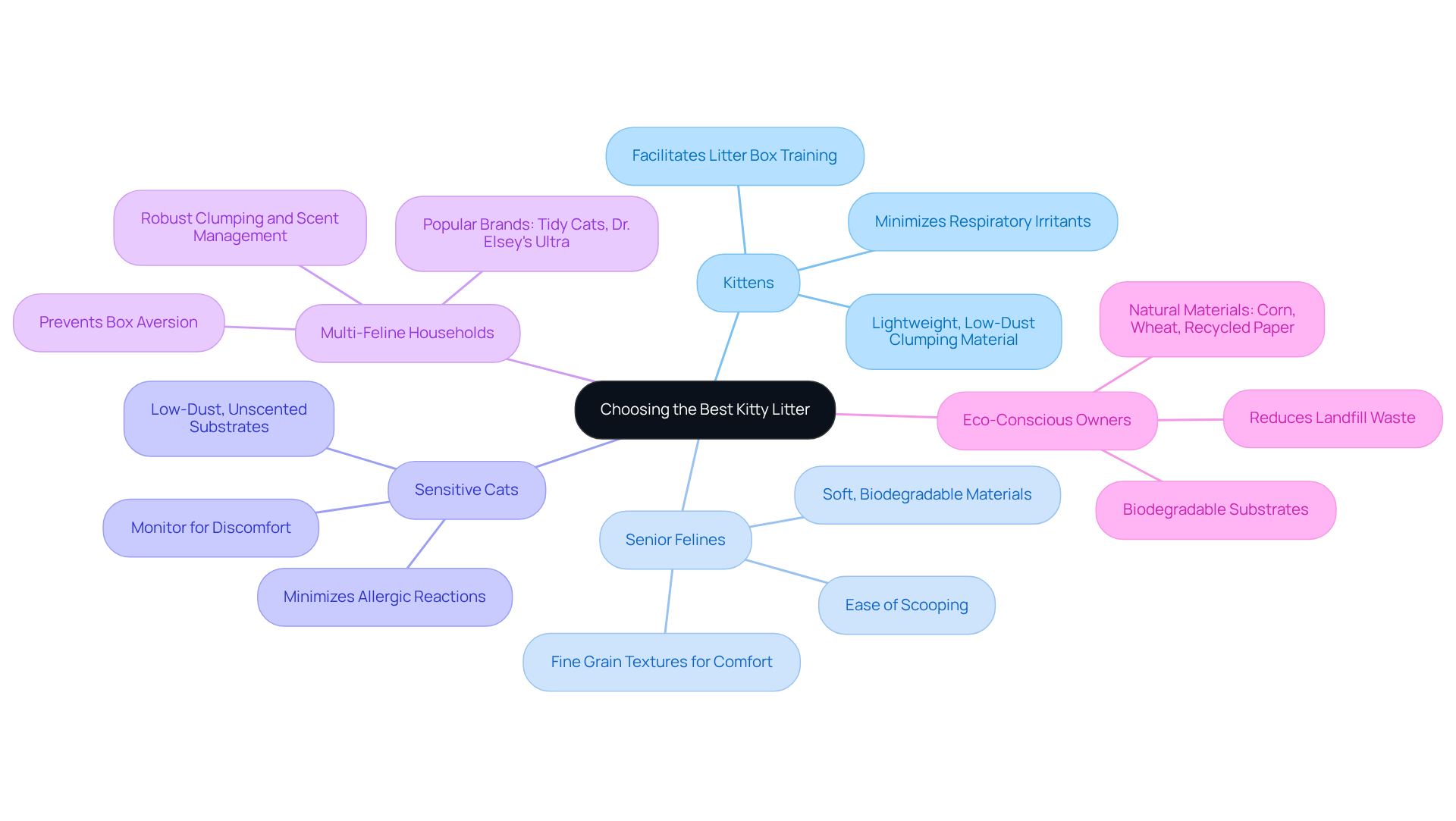
Conclusion
Choosing the best kitty litter is a crucial decision that significantly impacts the comfort and well-being of your beloved feline companions. Each type of litter offers unique benefits and drawbacks, catering to different preferences and needs. By understanding these options, you empower yourself to select the most suitable product, ensuring a cleaner and more nurturing environment for your cats.
This article explores various litter types, including:
- Clumping clay
- Non-clumping clay
- Silica gel
- Biodegradable options
- Crystal litter
It emphasizes the popularity of clumping materials for their ease of maintenance and odor control, while also addressing the growing demand for eco-friendly alternatives. Additionally, the analysis of leading brands showcases innovative features that enhance pet health monitoring and sustainability, providing valuable insights for conscientious cat owners like you.
Ultimately, the choice of cat litter should reflect the specific needs of each feline, whether it’s a playful kitten, a senior cat, or a sensitive pet. By considering factors such as comfort, odor control, and environmental impact, you can create a harmonious living space that prioritizes your cats’ health and happiness. This thoughtful approach not only fosters a nurturing environment but also contributes to a more sustainable future for pet care. Together, let’s ensure that your furry family members thrive in a loving and supportive home.
Frequently Asked Questions
What are the different types of cat litter available?
The main types of cat litter include clumping clay litter, non-clumping clay litter, silica gel litter, biodegradable litter, and crystal litter.
What is clumping clay litter and why is it popular?
Clumping clay litter is made from sodium bentonite clay and forms solid clumps upon contact with moisture, making it easy to scoop and maintain. It is the most preferred choice among cat caregivers, with 64% favoring it for its practicality and efficiency in managing odors.
How does non-clumping clay litter differ from clumping clay litter?
Non-clumping clay litter absorbs moisture without forming clumps, which means it requires more frequent changes. While it is generally more budget-friendly, it may demand additional effort to maintain cleanliness.
What are the benefits of silica gel litter?
Silica gel litter is composed of silica crystals that excel in moisture absorption and odor control. It typically lasts longer than clay options, making it suitable for busy households, although some cats may not prefer its texture.
What is biodegradable litter and why is it gaining popularity?
Biodegradable litter is made from eco-friendly materials such as corn, wheat, pine, and recycled paper. It is becoming popular among environmentally conscious pet owners for its effective scent management and sustainability.
What is crystal litter and what are its characteristics?
Crystal litter consists of tiny crystals that absorb moisture and control odors effectively. It generates minimal dust and has a longer lifespan than conventional clay products, though some cats may find it less comfortable.
What trends are emerging in the cat waste market?
There is a growing preference for clumping products, with the global cat waste products market projected to reach USD 16.63 billion by 2030. Additionally, many consumers are purchasing extra-strength odor control products, highlighting the importance of odor management.
Why do veterinarians recommend clumping litter?
Veterinarians often recommend clumping litter for its convenience and ability to create a cleaner box environment, which is essential for a cat’s health and well-being.

